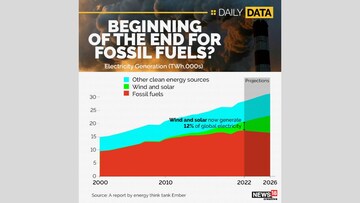
Carbon, capture, utilisation, storage (CCUS) is another alternative for achieving net zero emissions, but the technology is still in its pilot stage, said RK Singh, the Union minister of power and new and renewable energy on Tuesday.
Briefly explaining what CCUS is, Singh said, "For example, you use coal to produce electricity or coke to produce steal, you capture the carbon dioxide and other greenhouse gases that are emitted. And then you place it in some tunnel or mine and hope it does not leak back again," he said, adding that the technology is there, but in its pilot stage.
What is CCUS?
To simplify it further, CCUS involves capturing carbon dioxide from large point sources like industrial or power generation facilities that utilise either biomass or fossil fuels as fuel. The gas can also be captured from the atmosphere directly. If the captured gas is not used at the site, it is compressed and then transported via ship, pipeline, truck or rail, to be utilised in various applications or inserted into deep geological formations which trap the gas for permanent storage. These can also include depleted oil as well as gas reservoirs or even saline aquifers.
Latest developments on CCUS
According to the most recent International Energy Agency (IEA) report (September 2022), globally there are about 35 commercial facilities in operation that apply CCUS to industrial processes, power generation and fuel transformation, to capture around 45 metric tonnes of CO2 annually.
The IEA report stated that the CCUS momentum showed growth since 2018, but has been slow. It added that project developers announced their aim to develop more than 200 new capture facilities to be operational by 2030, which would capture over 220 metric tonne of carbon dioxide every year. However, only about 10 such commercial projects that were under development took the final investment decision (FID) as of June last year.
Role in net zero transition
The report stated that higher carbon dioxide capture rates would be essential for the method to play its role in the net zero transition. McKinsey in its recent blog too said that creating CCUS hubs could accelerate development. It said that strategically building CCUS hubs close to clusters of large emitters could help lower costs as well as accelerate scale-up.

NITI Aayog in its November 2022 'CCUS policy framework and its deployment mechanism in India' report said CCUS projects would need an upfront investment of $100-150 billion for around 750 metric tonnes per annum of CO2 capture, storage and utilisation.
It stated that these investments would have a positive impact on the country's GDP, which is estimated at around $100 billion to $150 billion in the next 30 years, based on the envisaged indigenization and improvement of CCUS technology.
Value chain
The NITI Aayog report states that to deploy carbon capture at a large scale, it is necessary to look beyond the technology aspect and look at the value chain, which is divided into three components:
Focus on dedicated storage
Carbon dioxide can bring a few climate benefits, however the market size of these applications is relatively limited, which is why the primary focus is dedicated storage of CCUS deployment, the IEA report stated.
It added that when it comes to the net zero scenarios, more than 95 percent of the gas captured by 2030 is to be stored geologically and less than 5 percent of it is supposed to be used.
While CCUS is just one aspect of achieving net zero emissions, countries across the world, including India are also focusing on other measures to transition to green energy. Singh in his address also highlighted another important point: "You won't get to net zero until you have round-the-clock renewable energy. And for that you need storage." While he was talking about other storage solutions for other sources of renewable energy, this also applies to the CCUS technology as well.
(Edited by : Abhishek Jha)
First Published: Apr 11, 2023 5:10 PM IST
Check out our in-depth Market Coverage, Business News & get real-time Stock Market Updates on CNBC-TV18. Also, Watch our channels CNBC-TV18, CNBC Awaaz and CNBC Bajar Live on-the-go!


PM Modi to contest from Varanasi, to file nomination papers on May 14
May 5, 2024 2:49 PM
Prajwal Revanna's father in custody for alleged kidnapping and sexual abuse
May 4, 2024 7:53 PM
Delhi, Indore, Surat and Banswara — why these are the most challenging domains for Congress internally
May 4, 2024 1:53 PM
Congress nominee from Puri Lok Sabha seat withdraws, citing no funds from party
May 4, 2024 12:00 PM

